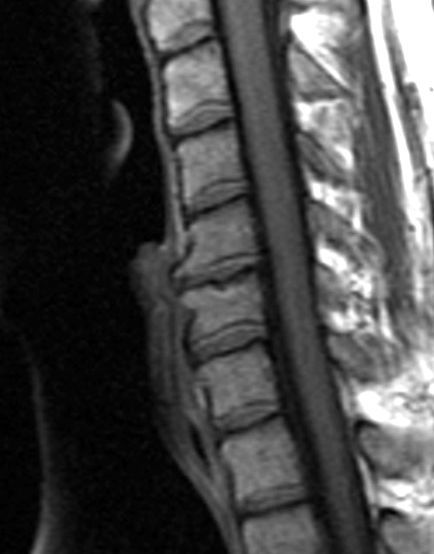In order to understand this topic it is important to understand the basic anatomy of the spine. Please review the section on basic spine anatomy before reading this section. To understand how the spine works, please review the section on the basic spine biomechanics.

What is degenerative disc disease of the neck?
Degenerative disc disease is the term used to describe degeneration or “wearing out” of the intervertebral discs of the spine. Degenerative disc disease of the neck is a common condition that is a major cause of neck pain in the older adult population.
What is the intervertebral disc of the neck?
The intervertebral disc is a structure that is located between the bodies of each vertebra in the spine. These discs act as spacers between the vertebrae and they also function as shock absorbers. Each disc is made up of a gel-like center called the “nucleus pulposis”, and a tough outer layer called the “annulus fibrosis”. In the neck the nucleus pulposis is relatively small and the intervertebral disc is mostly made up of the annulus fibrosis.
Why does degenerative disc disease happen in the neck?
As people age the structure of the intervertebral disc changes. The disc begins to contain less water and it may also begin shrink. Normal, age-related wear and tear changes of the disc and previous neck injuries make people susceptible to this condition.
What happens after the cervical intervertebral disc degenerates?
As the intervertebral disc degenerates, wear and tear arthritis (osteoarthritis) may develop in the spine. Osteoarthritis and the formation of bone spurs can occur as the result of damage to the intervertebral discs and increased stress on the facet joints of the spine. As osteoarthritis develops there is an increased risk of spinal stenosis (narrowing of the tunnels in which the spinal cord or the nerves coming off the spinal cord travel).
What does degenerative disc disease of the cervical spine feel like?
People with degenerative disc disease may complain of neck pain and/or stiffness. If there is compression of the nerves that come off the spinal cord the pain may radiate into the shoulders or down the arms into the hands. The pain may be associated with numbness, tingling or in severe cases, weakness in the arms. If the narrowing also occurs in the area through which the spinal cord travels, there may be symptoms in the legs as well. People may complain that certain positions and activities aggravate their pain. These problems usually develop slowly, over a long period of time.
Where does degenerative disc disease happen?
Degenerative disc disease can occur anywhere in the spine but it is most common in the lower cervical spine (lower neck) and in the lumbar spine (low back). At this stage it is still unknown why degenerative disc disease occurs. As mentioned above, normal wear and tear of the disc and previous spinal injuries may make people more susceptible to this condition.
How is degenerative disc disease of the neck diagnosed?
The first step in the diagnosis of degenerative disc disease is to obtain a good medical history and perform a physical examination. X-rays of the bones of the neck may help to confirm degenerative disc disease. X-rays may show a loss of disc height and bone spur (osteophyte) formation. Depending on the severity of the problem, further tests such as MRI and CT scans may also be required.
What is the treatment for degenerative disc disease of the neck?
Treatment for degenerative disc disease should involve a team approach. Most types of treatment for degenerative disc disease work best when started early, before the disc has degenerated a great deal. For this reason establishing a correct diagnosis is important. Available treatments include exercises, medications, education on activity modification and spinal posture, bracing and in severe cases surgery. Unfortunately degenerative disc disease has no known cure. Doctors and Physical Therapists that deal with people with degenerative disc disease can help outline an individualized treatment program.
What other information is available on degenerative disc disease of the neck?
Back Pain Info / Neck Pain Info’s links section has additional information on this topic. Links have been provided to other websites as well as online medical journals. Visit Joint Pain Info. Com for information on other joint injuries and problems.
